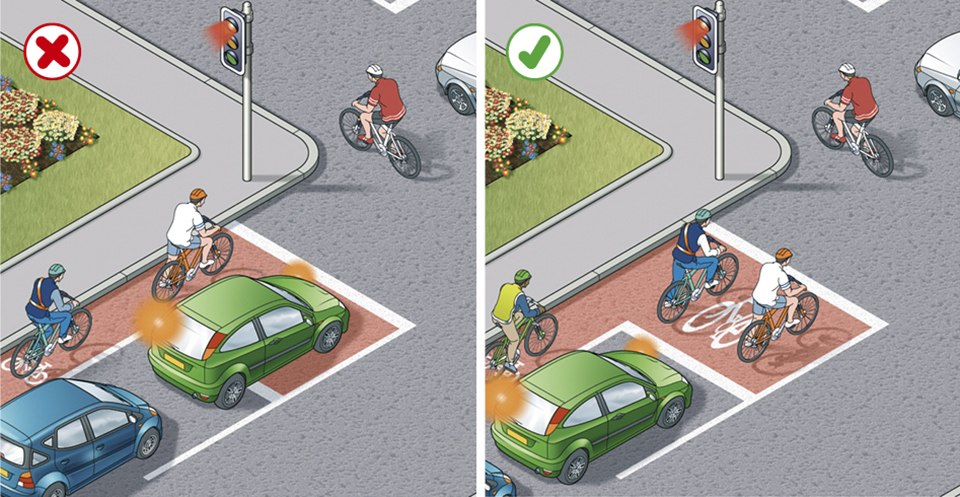Someone passed me this link to a discussion forum thread on Horse & Hound (EDIT: I note that it has been picked up by a driving forum, too). I’ve linked to Horse & Hound before, as they had a very useful story about the dangers of taking pupils’ kids out on lessons (I am totally against the practice, and that story illustrates why).
This particular thread concerns a horse rider who has commented that a learner driver passed them on a blind bend, and wouldn’t have been able to deal with a car coming the other way. It’s a fair and relevant comment. However, especially in view of the subsequent replies, I want to comment on the author’s original claims.
The original poster says (all spelling and grammar left intact):
very rare we have to encounter roads but when we do we are as polite as possible and in hi viz… but just a thought as so many fatalities with horses recently etc… when i passed my test many moons ago we were taught to pass slowly and only when safe, this lady has been told to pass on blind bend etc…we all have our woes on the road but just curious as to wether the rise in horse accidents isnt just because there are more cars on road but partly because learner drivers are not informed when encountering riders etc ???
First of all, it might be “very rare” for the author to encounter roads, but it is standard daily practice for horse riders at various stables near me to ride out on the roads (and I suspect this is true of the majority of riders). They have to, and there’s nothing wrong with that. Sometimes, these “roads” are 50mph and 60mph ‘A’ roads with roundabouts on them! However, not all riders wear hi-visibility jackets – those who do are the exception rather than the rule – nor do all of them ride in single file on narrow rural roads as they should do (though I must add that most do).
Next, not all riders are as “polite as possible” (again, I will add that most are). Those riding racehorses (we have a racing stable not far away) or other magnificent animals seem to be the most ignorant, though the practice of not acknowledging drivers who slow down and pass carefully seems to be growing – I’ve noticed that it is becoming especially evident among the younger female riders these days (in the past, they have been friendly and polite).
The rider who posted those comments assumes that the learner in question was actually told to drive incorrectly. They assume that the supervising driver had sanctioned it – both before and after the event. The author then suggests that “the rise in horse accidents” is down to all learner drivers not being taught to drive properly. This is simply not true.
Horse riders have rules of their own they’re supposed to follow in the HC. As I’ve said, not all of them wear hi-viz gear or stay single-file on narrow roads, and I can add that not all of them use hand signals properly or at all. Around here, for example, it is not uncommon for them to wave following traffic through on blind bends when they can see it’s clear – they’re only being helpful, of course, but the rules about beckoning others apply to all road users, not just cars.
The bottom line is that no one is perfect – not even horse riders.
The Highway Code (HC) says regarding drivers and horses:
215
Horse riders and horse-drawn vehicles. Be particularly careful of horse riders and horse-drawn vehicles especially when overtaking. Always pass wide and slowly. Horse riders are often children, so take extra care and remember riders may ride in double file when escorting a young or inexperienced horse or rider. Look out for horse riders’ and horse drivers’ signals and heed a request to slow down or stop. Take great care and treat all horses as a potential hazard; they can be unpredictable, despite the efforts of their rider/driver.
It’s there in black & white – every driver should be following that advice, and every driver should be encouraging others to do the same, particularly if they are instructors or supervising drivers. But those who don’t are really no worse than the horse riders who don’t follow their rules, or who stare sullenly at (or totally ignore) those who slow down and give them a wide berth. Speaking specifically about learner drivers, the ones who drive dangerously around horses are in a minority.
Speaking for myself, I actively seek out roads where horses and stables – and other animals – are likely to be found and teach my own pupils how to handle the situations properly (in the past, I’ve even stopped and got out if I’ve seen a smart-looking horse or pony just to comment on it). I have my own internal alarms, and there is no way one of my learners is going to overtake anything if I can’t be sure it’s safe to do so. So I obviously resent the implication in the thread-starter’s original post.
The problems are not with learner drivers (yawn!) but with society in general. The horse rider who doesn’t acknowledge courteous drivers, or who waves cars past on bends (no matter how well-intentioned) could easily end up teaching their own kids to drive at some point, after all. What message will they pass across?
I tell my learners that if they get a smile and a wave then they’ve done the right thing… but more and more often I have to add that that was one miserable little git on that horse, and I then relate my experiences with the local racehorse riders.
But I just have to quote one of the replies to the original forum post in full:
I have seen a lot of learners recently, in proper driving school cars, who have been completely ignoring the rules of the road, everything from lack of indicating and sudden stops for no reason, to dangerously pulling out on a roundabout when they didn’t have right of way. It wasn’t that many years ago I passed (or was it…?) but my instructor would never have let me get away with any of it, surely they have a brake pedal for a reason?
Admittedly none of this was when I was riding, but it seems they are just as bad even when there aren’t any horses around!
Yes, dear. And when YOU started learning to drive, you’ve obviously forgotten that that’s exactly what you are doing Learning.
You didn’t brake smoothly. You stopped suddenly. You forgot to indicate – often discovering that even when you remembered to, you’d indicated too soon, too late, or the wrong way. And I expect you were the same when you first got on a horse.
Horse riders have every right to use the roads. But roads are primarily for cars, and horses are more easily damaged. People – both riders and drivers – have to learn how to use them properly.

 Well, it’s started.
Well, it’s started. When I’m teaching pupils, and particularly at the beginning of their training, absolutely the worst thing they can try to do is more than one thing at once. That’s because no one can do two or more things simultaneously – it just looks like they can once they become better at certain aspects of driving.
When I’m teaching pupils, and particularly at the beginning of their training, absolutely the worst thing they can try to do is more than one thing at once. That’s because no one can do two or more things simultaneously – it just looks like they can once they become better at certain aspects of driving. Reference points – when established BY the driver FOR the driver – can be very useful. In fact, everyone uses them one way or another no matter how much they might try to deny it.
Reference points – when established BY the driver FOR the driver – can be very useful. In fact, everyone uses them one way or another no matter how much they might try to deny it. This one shows what it’s like now, with the shiny new barrier.
This one shows what it’s like now, with the shiny new barrier.
 With all due respect to “the lady” who has complained, if car fumes are affecting her lung condition – and I seriously doubt that – the effect will be a thousand times worse as a result of the mummies and daddies who park dangerously outside the school for hours at a time when they come to pick up their little darlings (the school “specialises in the dramatic arts”, so you can imagine the mummy-o-meter being off the scale most of the time). It’s horrendous down there most of the day, and not from learners. The specific complaint here is against learners – not car fumes – and it is part of a concerted attempt by someone to get their own way (the notice at the test centre being part of the campaign).
With all due respect to “the lady” who has complained, if car fumes are affecting her lung condition – and I seriously doubt that – the effect will be a thousand times worse as a result of the mummies and daddies who park dangerously outside the school for hours at a time when they come to pick up their little darlings (the school “specialises in the dramatic arts”, so you can imagine the mummy-o-meter being off the scale most of the time). It’s horrendous down there most of the day, and not from learners. The specific complaint here is against learners – not car fumes – and it is part of a concerted attempt by someone to get their own way (the notice at the test centre being part of the campaign).